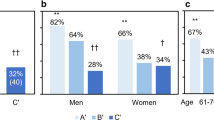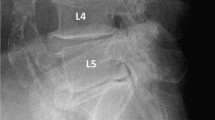Abstract
The present study analyzes the frequency (prevalence rates) of vertebral pain syndrome (VPS) in 2844 women aged 40–89 years divided into groups based on the reproductive, perimenopausal and postmenopausal (PMP) stages of life and evaluates the relationship between the VPS rates and scores of bone mineral density (BMD). The overall VPS rates range from 84.1 to 94.4% throughout the different physiological stages of woman’s life, with a statistically significant increase in the PMP stage of 20 years duration or longer when compared with the reproductive and early postmenopausal stages. Significant growth of the VPS rates in the thoracic and lumbar regions of spine begins in the first to third years of PMP period (stage); the frequency remains high throughout all subsequent periods of PMP. Postmenopausal women are found to demonstrate a significant increase in the relative risk of developing VPS in the thoracic (1.3- to 1.4-fold) and lumbar (1.2- to 1.3-fold that) regions of the spine. Patients with osteoporosis in 1–3 years of PMP duration display significantly higher rates of VPS in the thoracic spine than women with osteopenia, while patients with 7–9 years of PMP duration have significantly increased rates as compared with groups that include osteopenia and norms. In patients with osteoporosis and no history of vertebral fractures, the VPS prevalence rates in the thoracic spine significantly increase in PMP periods of 4–6 and 7–9 years duration as compared with women in the reproductive stage, as well as in women with normal BMD scores. The identified VPS patterns can be of value in the planning of therapeutic interventions in women of senior age groups.
Similar content being viewed by others
References
Bol’: prakticheskoe rukovodstvo dlya vrachei (Pain: Practical Manual for Physicians), Yakhno, N.N. and Kukushkin, M.L., Eds., Moscow: Ross. Akad. Med. Nauk, 2011.
Povoroznyuk V.V., Grygorieva, N.V., Orlyk, T.V., et al., Osteoporoz v praktike vracha-internista (Osteoporosis in the Practice of an Internist), Kyiv: Ekspres, 2014.
Shostak, N.A. and Pravdyuk, N.G., Back pain associated with osteoporosis: an algorithm of treatment and therapy, Klinitsist, 2012, vol. 6, no. 1, pp. 86–90.
Briggs, A.M., Straker, L.M., and Wark, J.D., Bone health and back pain: what do we know and where should we go?, Osteoporosis Int., 2009, vol. 20, pp. 209–219.
Dugan, S.A., Powell, L.H., Kravitz, H.M., et al., Musculoskeletal pain and menopausal status, Clin. J. Pain, 2006, vol. 22, pp. 325–331.
Hayashi, Y., Bone diseases with pain, Osteoporosis Clin. Calcium, 2007, vol. 17, no. 4, pp. 606–612.
Poomalar, G.K. and Arounassalame, B., The quality of life during and after menopause among rural women, J. Clin. Diagn. Res., 2013, vol. 7, no. 1, pp. 135–139.
Kozinoga, M., Majchrzycki, M., and Piotrowska, S., Low back pain in women before and after menopause, Przegl. Menopauzalny, 2015, vol. 14, no. 3, pp. 203–207.
McCarthy, J. and Davis, A., Diagnosis and management of vertebral compression fractures, Am. Fam. Phys., 2016, vol. 94, no. 1, pp. 44–50.
Mitchell, E.S. and Woods, N.F., Pain symptoms during the menopausal transition and early postmenopause, Climacteric, 2010, vol. 13, pp. 467–478.
Park, J.J., Shin, J., Youn, Y., et al., Bone mineral density, body mass index, postmenopausal period and outcomes of low back pain treatment in Korean postmenopausal women, Eur. Spine J., 2010, vol. 19, no. 11, pp. 1942–1947.
Paulis, W.D., Silva, S., Koes, B.W., and van Middelkoop, M., Overweight and obesity are associated with musculoskeletal complaints as early as childhood: a systematic review, Obes. Rev., 2014, vol. 15, no. 1, pp. 52–67.
Perovic, D. and Boric, I., Diagnostics and treatment of osteoporotic vertebral fractures, Reumatizam, 2014, vol. 61, no. 2, pp. 75–79.
Wáng, Y.X., Wáng, J.Q., and Káplár, Z., Increased low back pain prevalence in females than in males after menopause age: evidences based on synthetic literature review, Quant. Imaging Med. Surg., 2016, vol. 6, no. 2, pp. 199–206.
Haegerstam, G.A.T., Pathophysiology of bone pain, Acta Orthop. Scand., 2001, vol. 72, no. 3, pp. 308–317.
Author information
Authors and Affiliations
Corresponding author
Rights and permissions
About this article
Cite this article
Orlyk, T.V., Grygorieva, N.V. & Povoroznyuk, V.V. Patterns of Vertebral Pain Syndromes in Women of Older Age Groups Depending on Duration of Postmenopausal Period and Bone Mineral Density Score. Adv Gerontol 7, 328–335 (2017). https://doi.org/10.1134/S2079057017040105
Published:
Issue Date:
DOI: https://doi.org/10.1134/S2079057017040105




